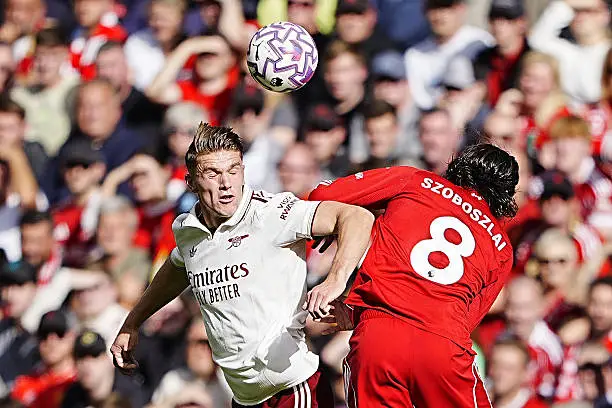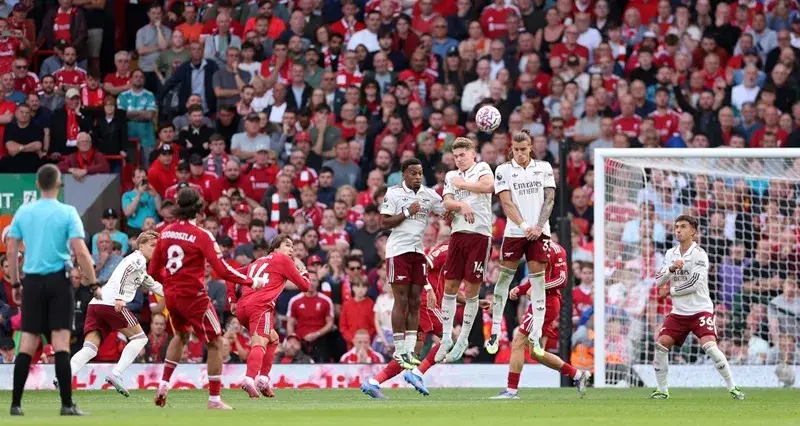Liverpool Edge Past Arsenal with a Moment of Magic—a phrase that perfectly captures the essence of a tight, highly strategic battle where moments of individual genius shine brightest amid tactical chess matches. This particular game was a testament to how football, at its highest level, often hinges on a single defining act, a moment of inspiration that can tilt the scales in an otherwise evenly matched contest. The clash between Liverpool and Arsenal wasn’t just a game of chances; it was a battlefield where meticulous planning and raw talent intertwined to produce a spectacle that kept fans on the edge of their seats. From the low xG statistics to the tactical nuances, everything pointed to a contest defined by precision, discipline, and serendipitous brilliance.
More Manchester United Snatch Lucky Win Over Burnley in Round 3 EPL 25-26: Match Highlights Analysis
The game was a clinic in understanding football as a sport of fine margins. Both managers, Slot and Arteta, knew their opponents well, each team’s strengths, weaknesses, and tendencies clearly mapped out through extensive analysis. The players responded accordingly; Arsenal, dominant in the first half, frustrated Liverpool’s build-up and limited their attacking outlets. Conversely, Liverpool came alive in the second period, controlled the game’s tempo, and crafted the winning moment through a blend of tactical adjustments and individual skill.
This match stands out not merely because of the final score but because of how a solitary act — a breathtaking free-kick from Szoboszlai — became the defining feature of an otherwise cautious and calculated game. It epitomized the idea that football is often about moments, tiny windows of brilliance where natural talent overcomes strategies, and individual flare reshapes the outcome. The arena at Anfield bore witness to a memorable night where one maestro’s singular strike carved his name into matchday legend, proving once again that in football, the extraordinary can emerge from the most ordinary-looking phases of play.
The Low xG Battle – A Tight Game of Strategy and Discipline
In a match where chances were few and far between, the expected goals (xG) statistics reflected the caution and precision of the two sides. Liverpool’s xG stood at just 0.34, while Arsenal’s was marginally higher at 0.37, marking this as the lowest xG game in the current Premier League season. This data reveals how both teams prioritized containment, disciplined defending, and strategic patience over open, end-to-end attacking football.
The low xG is emblematic of a fixture that was less about chaos and more about meticulous planning. Both Slot and Arteta had evidently studied each other extensively, deploying defensive structures that minimized risk while ensuring their players could exploit openings when they arose. Arsenal’s ability to stymie Liverpool’s transition and the Reds’ success in neutralizing crosses and set-pieces kept the chances scarce, leading to a tense, almost chess-like atmosphere on the pitch. This speaks volumes about the tactical awareness of both coaching teams, each making slight adjustments in response to opponent movements, leading to a game where momentary lapses could prove fatal.
Such a tactical environment heightens the importance of individual heroism. When chances are scarce, the odds of a moment of pure brilliance rising from the chaos diminish but do not vanish. As a result, every key play, every clever interception, and especially, the rare moments where players find space and time become the focal point. This game was a reminder that in football, especially at the highest level, mastery isn’t just about creating dozens of opportunities but excelling in the efficiency and precision of the chances you do get — a lesson well heard during this tightly contested battle.
Tactical Approach – How Both Managers Sought to Outwit Each Other
The strategic duel between Mikel Arteta and Arne Slot was a fascinating subplot of this encounter. With both teams well-drilled and tactically astute, the game unfolded as a series of subtle adjustments, positional tweaks, and mind games off the pitch. Arsenal’s initial dominance in possession and sharp pressing in the first half was a clear statement of intent, trying to dominate the game through control and quick transitions.
Arsenal’s pressing organization—particularly their offside traps and high-intensity closing—effectively dismantled Liverpool’s build-up, forcing the Reds into uncharacteristic errors. On the other side, Liverpool adapted by shifting to a more direct approach in the second half, utilizing long balls and exploiting the wings through quick switches. Slot’s decision to bring Curtis Jones on was a masterstroke, injecting energy and skill that disrupted Arsenal’s defensive rhythm and paved the way for Liverpool’s late winning goal.
Each coaching team displayed an intricate understanding of their opponent’s tendencies. Arsenal’s defense was adept at closing down passing lanes, particularly in restricting Liverpool’s midfield orchestrator Szoboszlai, demonstrating a collective understanding of team shape. Conversely, Liverpool’s strategic switch to bypass Arsenal’s press in the second half and incorporate verticality was an example of tactical flexibility, highlighting how managers must read and adapt under pressure. This mutual tactical chess game emphasized the high level of football intelligence at play, with a game plan that was flexible and reactive, culminating in a tense and gripping contest that kept spectators guessing.
The Individual Brilliance – The Moment of Magic That Changed Everything
The highlight of this game — and the defining moment — was undoubtedly Dominik Szoboszlai’s exquisite free-kick, a piece of individual genius that awarded Liverpool their only goal and ultimately secured victory. The set-piece came after a foul on Jones, who showcased resilience by persisting to win the foul despite being closely marked. The 30-meter free-kick was not taken lightly; Szoboszlai’s experience and confidence shone through as he prepared for the shot.
The Hungarian midfielder, renowned for his precision and shot power, had studied Raya’s tendencies meticulously. Known for his formidable free-kicks, Szoboszlai preempted Raya’s usual jumping pattern, selecting a carefully calibrated shot that soared into the top corner, out of reach of the goalkeeper. This moment of individual brilliance was not just about technical skill but also football intelligence. Szoboszlai’s ability to analyze the goalkeeper’s movement and execute perfectly under pressure exemplifies why he is regarded as a burgeoning genius of the game.
This goal embodied the essence of football’s unpredictability. Even in a game dominated by tactical discipline, a single player’s moment of inspiration can redefine the entire narrative. Szoboszlai’s strike was a reminder that greatness often resides in the details—the subtle, almost unnoticed preparations that culminate in pure, unadulterated brilliance. The celebration that followed, the subsequent tactical adjustments, and the reactions of teammates and opponents alike underscored how one moment of magic can ripple through a match, imbuing it with unforgettable significance.
Szoboszlai’s Rise – From Emerging Talent to Match-Winner
Since donning the Liverpool shirt, Szoboszlai has demonstrated he is more than just a promising prospect — he is a pivotal figure capable of influencing big matches. His arrival at Anfield has been characterized by a compelling blend of ruthless efficiency, tactical flexibility, and undeniable talent. This game solidified his status not just as a rising star, but as a bona fide match-winning force.
Szoboszlai’s versatility is one of his standout qualities. He can operate effectively across multiple midfield roles: as a box-to-box player, a deep-lying playmaker, or even as a right winger, where he often helps to transition defense into attack. His physical attributes, including impressive stamina, strong physique, and precise passing, allow him to adapt to different tactical situations dynamically. He is a player who can impose himself physically, as seen in his duels with Martinelli and Gyokeres, while also possessing the technical finesse to execute set-pieces with lethal accuracy.
His evolution since arriving at Liverpool has been remarkable. The confidence displayed in this game, especially during his free-kick that sealed the victory, indicates a player who has matured beyond his years. Under the guidance of Klopp’s coaching staff, Szoboszlai has learned to combine instinct with tactical discipline, making him a nightmare for defenders and a reliable leader on the pitch. His ability to deliver in crucial moments, especially in high-stakes games, is a testament to his mental fortitude and technical skill. As he continues to develop, he could undoubtedly become one of the most influential players in European football, and this victory will serve as yet another defining milestone in his ascent.
The Legacy of Anfield Legends – Szoboszlai and Gerrard’s Shared Spirit
When contemplating the importance of Szoboszlai’s contributions, it’s fitting to reflect on the storied history of Liverpool’s Anfield, a stage that has hosted some of the game’s greatest talents. Legends like Steven Gerrard, who memorably led the Reds to Champions League glory in 2005, set a standard for what a Liverpool midfielder can achieve—a blend of leadership, skill, and resilience. Szoboszlai’s current trajectory echoes the spirit and versatility of Gerrard, suggesting that he might well carve out a similar legacy.
Gerrard’s transition from an attacking midfielder to a central figure responsible for many of Liverpool’s most memorable moments demonstrated the importance of vision, leadership, and individual brilliance. This duality—combining collective effort with moments of personal magic—remains a hallmark of Liverpool’s identity. Szoboszlai, with his energetic style, tactical intelligence, and ability to decisively influence matches, seems to be stepping into those same legendary footsteps.
The reverence with which Klopp’s team regards these players underscores the club’s appreciation for cerebral, technically gifted, and fiercely competitive athletes. This game, with its tight margins and singular moments of genius, reaffirms that true footballing greatness often hinges on personality as much as technical ability. Szoboszlai’s way of approaching the game, marked by resilience and brilliance, echoes the leadership traits that Gerrard exemplified. One can’t help but wonder if someday he will be remembered alongside Liverpool’s finest, achieving legendary status by combining individual magic with team success — just as the great former captain did in his time.
Conclusion
The night at Anfield where Liverpool edged past Arsenal with a moment of magic exemplifies football’s beautiful unpredictable nature. Both teams showcased tactical discipline, defensive resilience, and an understanding that in a game of few chances, individual brilliance can be decisive. Szoboszlai’s stunning free-kick illuminated the match, elevating him to the status of a true match-winner and adding another chapter to Liverpool’s storied history of legendary midfielders. His ability to deliver under pressure and adapt tactically underscores the qualities of a future icon capable of inspiring his team in tough battles. This game will be remembered not only for the result but also for how moments of individual talent can define a fixture and captivate fans—an enduring testament to football’s status as the beautiful game of hope, skill, and unforgettable magic.

